 |
| August 14, 2018 | Volume 14 Issue 30 |
Designfax weekly eMagazine
Archives
Partners
Manufacturing Center
Product Spotlight
Modern Applications News
Metalworking Ideas For
Today's Job Shops
Tooling and Production
Strategies for large
metalworking plants
Porsche flat engine tradition: 911 GT2 RS is the fastest Porsche 911 of all time
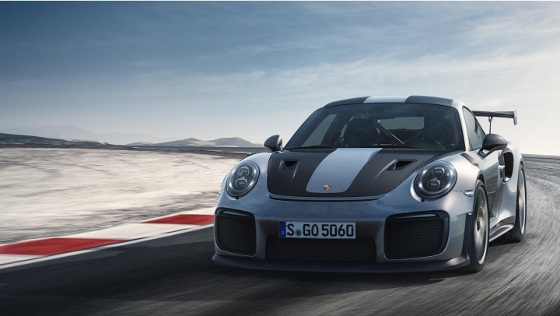
Porsche 911 GT2 RS. [All images courtesy: Porsche AG]
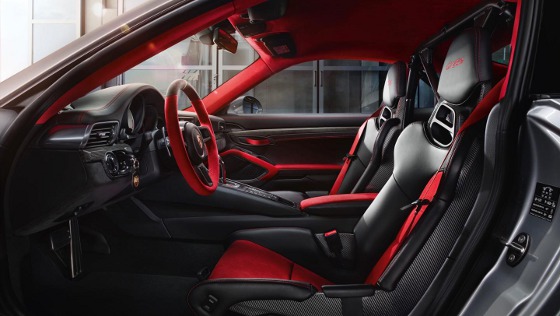
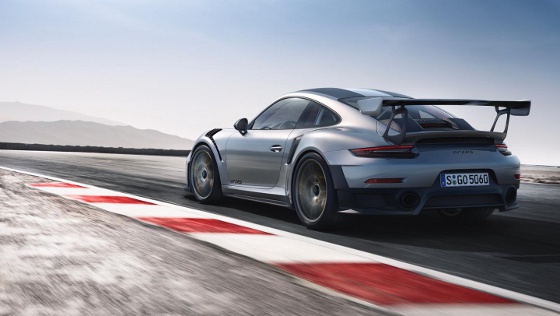
When people think of Porsche, the first thing that comes to mind is often the silhouette of the 911 -- and the flat engine. These engines are very close to every Porsche devotee's heart. But what is so special about this particular design principle for an internal combustion engine?
Emotions tell only half the story. As well as revving its way into the affections of many, the flat engine has many interesting features that give it the edge from a design point of view. Its history dates back 122 years to 1896, when Carl Benz invented the flat engine. He called it the contra engine, because its two cylinders worked in opposition to one another. This first boxer engine was intended to have a displacement of over 1.7 liters and deliver 5 hp. Its underlying design principle -- both then and now -- is that the cylinders should lie flat and slightly offset to each other, on opposite sides of the crankshaft.
The Porsche family tree of flat engines can be traced back to the VW Beetle. Its 1.1-liter, four-cylinder engine delivering 26 kW (35 hp) was installed by Ferry Porsche in his 356-001. Further engines followed, all of which were air-cooled until the 911 Type 993. In the top-of-the-range 911 Carrera RS, the 3.8-liter air-cooled flat engine achieved 221 kW (300 hp) without turbocharging. Two turbochargers boosted performance to 331 kW (450 hp).
The ideal choice for sports cars
The air-cooled flat engine is lightweight and flat, making it the ideal choice for sports cars, and particularly low designs are possible as the cylinders are lying flat. This lowers the center of gravity, allowing for a sportier and more dynamic style of driving -- and not just when cornering. If the flat engine is installed at the rear as in Porsche vehicles, traction is improved because the weight of the engine rests on the drive axle. Until all-wheel drive vehicles conquered the roads, Beetle and Porsche drivers agreed that a car with a rear-mounted engine was by far the best choice for winter conditions. The opposite is also true: When braking, the weight of a rear-mounted engine allows more braking force to be transferred to the rear wheels.
The flat engine -- and especially its six-cylinder variant -- is particularly smooth running, with no free moments or free forces. The crank mechanism is ideally balanced, allowing short-stroke sports engines to cruise along at high speeds without excessive strain.
Quick look: 3.8-liter six-cylinder twin-turbo boxer engine of the 911 GT2 RS
One of the most characteristic features of the Porsche six-cylinder flat engines is the drop in fuel consumption as engine power increases. The concept underlying the flat engine involves a consistent lightweight construction, a low center of gravity, outstanding revving ability, and a high specific output thanks to advantageous charge cycles. All 911 engines need to be sporty as well as suitable for everyday use.
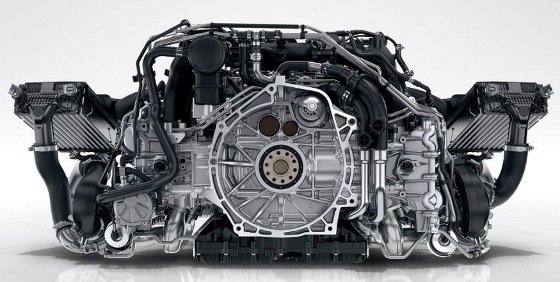
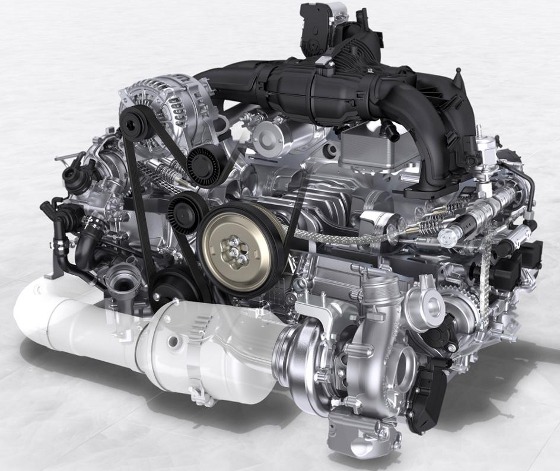
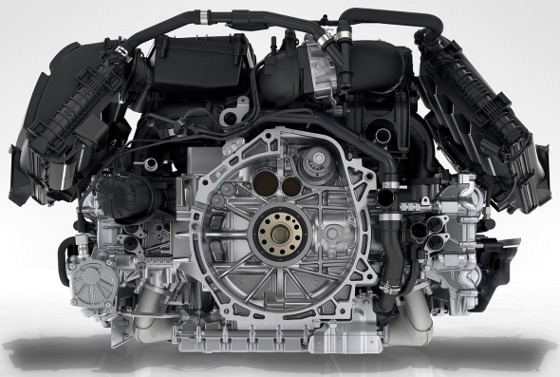
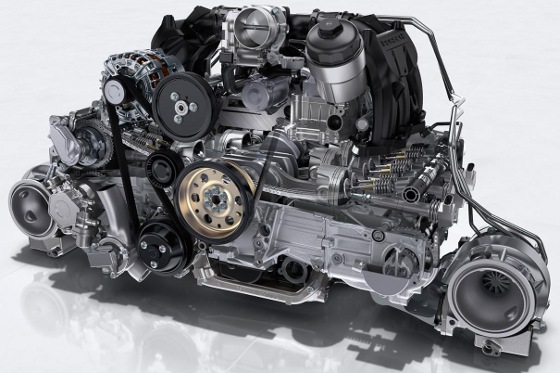
As a basic rule, it takes more effort to manufacture a flat engine than an in-line engine, because a greater number of parts is needed. The flat engine needs two banks of cylinders with a valve train, plus cooling or injection. The flat engine is a particularly good candidate for air cooling, because the individual cylinders are located far apart from each other and can therefore benefit from a direct flow of cooling air. The fact that the 911 flat engines have been water-cooled since the 996 model series is primarily a result of the four-valve technology. Four valves are a prerequisite for cutting fuel consumption and exhaust emissions while also boosting performance.
VIDEO: Top 5 most thrilling attributes of the Porsche 911 GT2 RS.
But this is only a point of interest for fans of water-cooled flat engines. No club with this name exists yet, but it surely will one day, when these engines stop being the latest technology and become part of history.
---------------------------------------------------
---------------------------------------------------
SIDEBAR: The fastest Porsche 911 of all time
Porsche set a new record for road-approved sports cars on the 20.6-km Nürburgring Nordschleife in the 911 GT2 RS on September 20, 2017. The record time of 6 min. 47.3 sec was achieved in the presence of a notary and surpassed even Porsche's own expectations. Frank-Steffen Walliser, vice president Motorsport and GT Cars, said: "At the start of the development process, we set ourselves a lap time target for the GT2 RS of less than 7 minutes and 5 seconds. The credit for beating this target by 17.7 seconds goes to our development engineers, mechanics, and drivers, who demonstrated an exceptionally strong team performance. This result makes it official: The GT2 RS is not only the most powerful, but also the fastest 911 ever built."
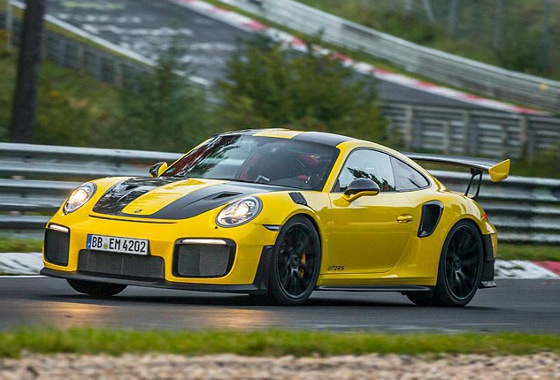
Porsche factory driver Nick Tandy traveled straight from a six-hour race in Austin, Texas, to the Nürburgring, swapping the Le Mans prototype Porsche 919 Hybrid for the 515-kW (700-hp) 911 GT2 RS with Michelin Pilot Cup 2 tires in impressive style. It was Lars Kern, a Porsche test driver by trade with a passion for racing, who ultimately set the final record time. Alongside the Carrera Cup Australia, Kern regularly competes in the VLN Endurance Championship on the Nürburgring and knows the Nordschleife inside out. The subsequent record lap began at 7:11 pm and finished 6 min. and 47.3 sec later in ideal outdoor conditions. As is customary for record drives, the time was measured along the 20.6-km stretch. The vehicle's average speed was 184.11 km/h.
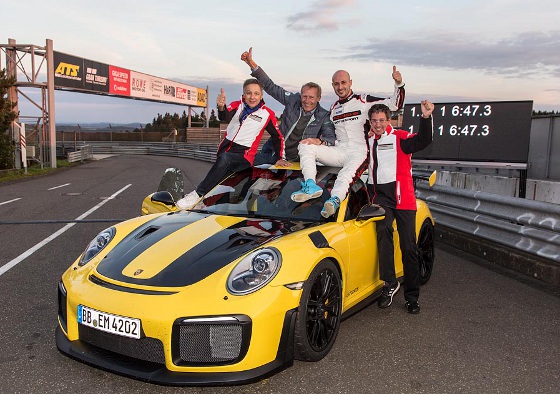
The fastest and most powerful road-approved 911 celebrated its world premiere at the Festival of Speed in Goodwood in the UK in June 2017. At the heart of this high-performance sports car is a 515-kW (700-hp) six-cylinder biturbo flat engine. Weighing in at 1,470 kg with a full fuel tank, the lightweight two-seater accelerates from zero to 100 km/h in 2.8 sec. The rear-wheel drive coupé has a top speed of 340 km/h, and with its near-motorsport drive technology, the new 911 GT2 RS trumps its 3.6-liter predecessor by 59 kW (80 hp) and achieves a torque of 750 Nm (an increase of 50 Nm).
Learn more about the 911 GT2 RS here. (We know you always want to know the price. Are you sitting down? Starts at $293,200.)
Source: Porsche AG
Published August 2018
Rate this article
View our terms of use and privacy policy
